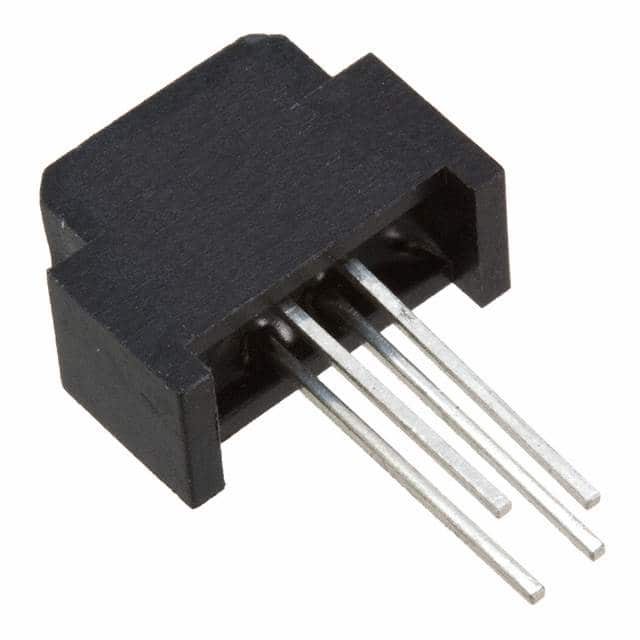OPB712: Product Overview and Detailed Information
Introduction
The OPB712 is a versatile product that belongs to the category of optical sensors. This device is widely used in various applications due to its unique characteristics and functional features. In this entry, we will provide an overview of the OPB712, including its basic information, specifications, detailed pin configuration, functional features, advantages and disadvantages, working principles, detailed application field plans, and alternative models.
Basic Information Overview
- Category: Optical Sensor
- Use: The OPB712 is used for detecting the presence or absence of an object by utilizing an infrared light-emitting diode (LED) and a phototransistor.
- Characteristics: The OPB712 is known for its high sensitivity, reliability, and compact design.
- Package: The device is typically available in a compact, durable package suitable for various mounting options.
- Essence: The essence of the OPB712 lies in its ability to accurately detect objects in a wide range of environments.
- Packaging/Quantity: The OPB712 is commonly available in reels or tubes, with varying quantities based on the manufacturer's specifications.
Specifications
The following are the general specifications of the OPB712: - Operating Voltage: 4.5V to 16V - Output Configuration: Phototransistor - Sensing Distance: Up to 0.125 inches (3.175mm) - Operating Temperature Range: -40°C to 85°C - Package Type: Through-Hole
Detailed Pin Configuration
The OPB712 typically consists of four pins, including power supply, ground, output, and emitter connections. The pinout configuration is as follows: 1. VCC (Power Supply) 2. GND (Ground) 3. OUT (Output) 4. EMITTER (Emitter)
Functional Features
The OPB712 offers the following functional features: - High Sensitivity: The device can detect objects with high precision and accuracy. - Compact Design: Its small form factor allows for easy integration into various systems. - Reliable Performance: The OPB712 delivers consistent performance across different operating conditions.
Advantages and Disadvantages
Advantages
- High sensitivity enables precise object detection.
- Compact design facilitates easy integration into space-constrained applications.
- Reliable performance ensures consistent operation in diverse environments.
Disadvantages
- Limited sensing distance may not be suitable for long-range detection requirements.
- Vulnerable to ambient light interference in certain operating conditions.
Working Principles
The OPB712 operates based on the principle of infrared light reflection. When an object is within the sensor's detection range, the emitted infrared light reflects off the object and is received by the phototransistor, causing a change in the output signal.
Detailed Application Field Plans
The OPB712 finds extensive use in various applications, including but not limited to: - Object Detection Systems - Robotics and Automation - Proximity Sensing - Industrial Machinery - Security Systems
Detailed and Complete Alternative Models
In addition to the OPB712, there are several alternative models available in the market that offer similar functionality and performance. Some notable alternatives include: - TCRT5000: A popular reflective optical sensor with comparable sensing capabilities. - QRE1113: Another infrared reflective sensor known for its reliable performance in object detection applications. - GP2Y0A21YK: An analog distance sensor suitable for proximity sensing and object detection.
In conclusion, the OPB712 is a highly versatile optical sensor with a wide range of applications and robust performance characteristics. Its compact design, high sensitivity, and reliable operation make it a preferred choice for many engineering and industrial applications.
Word Count: 536
Lista 10 Vanliga frågor och svar relaterade till tillämpningen av OPB712 i tekniska lösningar
What is OPB712?
- OPB712 is a reflective object sensor that consists of an infrared LED and a phototransistor.
What are the typical applications of OPB712?
- OPB712 is commonly used for object detection, position sensing, and line following in robotics and automation systems.
How does OPB712 work?
- The infrared LED emits light, which is then reflected off an object and detected by the phototransistor, allowing the sensor to determine the presence or absence of the object.
What is the operating voltage range of OPB712?
- OPB712 typically operates within a voltage range of 4.5V to 5.5V.
Can OPB712 be used for detecting transparent objects?
- OPB712 may have difficulty reliably detecting transparent objects due to their low reflectivity of infrared light.
What is the sensing distance of OPB712?
- The sensing distance of OPB712 can vary based on the specific application and environmental conditions, but it is typically in the range of a few millimeters to a few centimeters.
Is OPB712 suitable for outdoor use?
- OPB712 is primarily designed for indoor use and may not perform optimally in outdoor environments due to ambient light interference.
What is the output type of OPB712?
- OPB712 provides a digital output, typically in the form of a logic high or low signal based on the presence or absence of the detected object.
Can multiple OPB712 sensors be used together in a system?
- Yes, multiple OPB712 sensors can be used in parallel to cover larger areas or to provide redundancy in critical applications.
Are there any special considerations for mounting OPB712?
- It is important to mount OPB712 securely and ensure proper alignment between the LED and phototransistor for reliable operation. Additionally, minimizing ambient light interference is crucial for accurate sensing.


